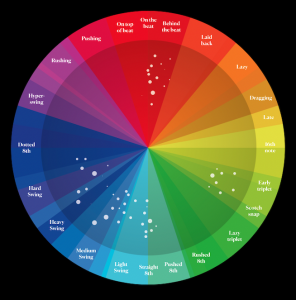Time-feel is a portfolio of papers, presentations, compositions and technological devices investigates the field of micro-rhythmic expression(or ‘Time-feel’), a fundamental but incompletely articulated musical component. In particular, it explores rhythmic concepts that are inadequately captured by the linear, onset- focused and gridded paradigm of standard music notation and terminology. As revealed by researchers over the past 30 years (e.g. Ellis 1991, Friberg 2002, Benadon 2007, Danielsen 2010, Dittmar 2017) there are copious (often tacitly ‘known’) rhythmic devices employed in wide cultural practice which ‘deviate’ from this standard notational rhythmic lattice (Wishart 1996) and yet hold expressive and stylistic salience. The rapid advance of digital audio processing has allowed researchers to examine these ‘micro-rhythmic’ devices closely and objectively, unfiltered by limitations of perception, established notation and terminology. However, the weight of current research is concerned with a passive post-hoc performance analysis, and not how these concepts might be developed, shared, taught and re-employed in performance and compositional practice. This project, which makes active use of technology in analysis, ‘real-time’ pedagogy, and compositional deployment closes this knowledge gap, and provides useful terminology and concepts for pedagogy and practice.
The papers in this portfolio represent significant contributions to the field, particularly in the separation and interaction of beat asymmetry (‘swing’) with ensemble phasing (‘latency’), a mechanism employed in jazz, pop, Latin and numerous global music cultures. These findings have been disseminated to its academic community however they have reached a wide cohort of practitioners beyond this narrow field, through the first ever popular publication of the field in Guitar Techniques Magazine (readership 20,000), micro-rhythmic etudes (Kronókosmos), and the Ableton-hosted Breaking 4/4 touring workshop. In addition, technological devices (Time Machines, Mingus) have been developed which allow the real-time analysis, pedagogical instruction and creative deployment of this fundamental but otherwise hidden aspect of musical expression.
References
Benadon, F. (2007) “A Circular Plot for Rhythm Visualization and Analysis,” Music Theory Online 13, no. 3
Danielsen, A. (2010) Musical Rhythm in the Age of Digital Reproduction. Farnham: Ashgate
Dittmar, C. et al (2017) “A Swingogram Representation for Tracking Micro-Rhythmic Variation in Jazz Performances,” Journal of New Music Research 47, no. 2: 97–113
Ellis, M. C, (1991) “An Analysis of “Swing” Subdivision and Asynchronization in Three Jazz Saxophonists,” Perceptual and Motor Skills 73, no. 3 (1991): 707–13
Friberg, A. & Sundström, A. (2002) “Swing Ratios and Ensemble Timing in Jazz Performance: Evidence for a Common Rhythmic Pattern,” Music Perception: An Interdisciplinary Journal 19, no. 3
Wishart, T. (1996) On Sonic Art, reprint. Amsterdam: Harwood

